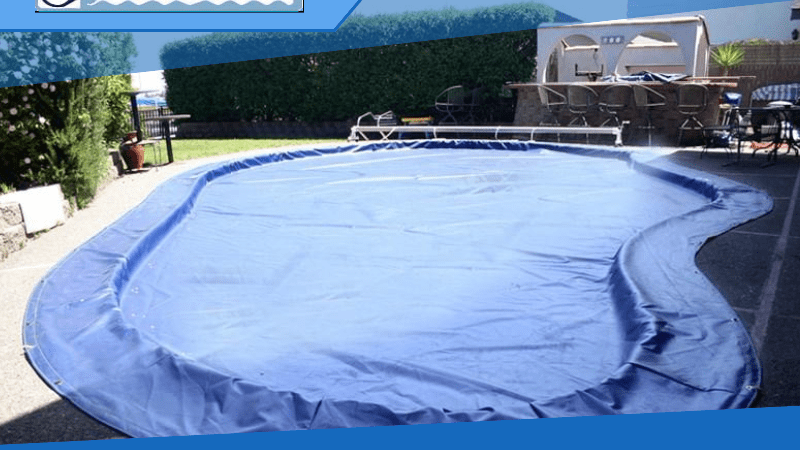
Swimming pool covers in Santa Rosa are great additions to your backyard water oasis. They withstand everything that’s thrown at them – dirt, debris, and harsh weather conditions – every day. In the process, pool covers save you money by preventing water and chemical loss due to evaporation, as well as heat loss. Safety pool covers, in particular, prevent unsupervised entry by children and pets, which otherwise could have led to tragic consequences.
That said, even pool covers made of the strongest and highest-quality material and craftsmanship depreciate in quality over time. If your old cover is so damaged that it can no longer protect your pool, you will eventually replace it with a new one.
How long is a pool cover’s useful life?
A pool cover’s useful life depends on its material and mechanism:
- Solar covers (plastic or polyethylene): These typically last 2-5 years. They are lightweight and provide heat retention but can degrade faster due to UV exposure.
- Mesh covers: Made from durable mesh fabric, they can last 8-15 years. They allow water drainage while keeping debris out and are UV—and weather-resistant.
- Solid vinyl covers: These have a lifespan of 6-10 years. They’re heavy-duty, providing excellent debris protection and preventing water evaporation, but may wear with time.
- Automatic covers: Made from reinforced vinyl and with mechanical components, they can last 7-10 years or more. Proper maintenance of both the cover and the mechanism is crucial to longevity.
Regular care and maintenance help extend a pool cover’s life, regardless of the type.
When should you replace your pool cover?

Here are key signs that your pool cover may need replacement:
- Tears, holes, or rips: Visible damage, like holes or rips in the cover, can compromise its effectiveness, letting debris and dirt enter the pool. If repairs aren’t possible, it’s time for a new cover.
- Sagging or stretching: If the cover is no longer taut and sags into the pool, it may have lost its elasticity or strength, reducing its ability to protect your pool.
- Water accumulation: Excessive water pooling on the cover indicates it’s no longer draining properly due to damage or wear in its drainage system, leading to added strain on the material.
- Worn or broken Straps: The straps and anchors that secure the cover to the pool should be intact. Broken or frayed straps reduce the cover’s stability, increasing the risk of it coming loose.
- Fading or discoloration: Over time, exposure to the sun’s UV rays can weaken the material, making it prone to tears. Severe fading or discoloration is a sign the cover may have deteriorated.
- Brittleness or stiffness: A cover that feels stiff or brittle when you handle it may be nearing the end of its lifespan, as prolonged exposure to weather and chemicals can cause the material to degrade.
- Increased dirt or debris in the pool: If you’re noticing more debris or contaminants in your pool, even with the cover on, it could be a sign that the cover is no longer providing an adequate seal.
Should you repair or replace your pool cover?
Whether you need to repair or replace your pool cover depends on its condition and the type of damage it has sustained. Here are some factors to consider:
When to repair your pool cover:
- Small tears or holes: Minor damage should need patching using a pool cover repair kit, typically including adhesive patches or tape.
- Broken straps or fasteners: If straps or fasteners are damaged, they may need replacement, but the cover itself is in good shape.
- Worn areas: If the cover shows signs of wear in non-critical areas, reinforcing those sections may extend its life.
- Minor fading: Sun damage leading to color fading doesn’t affect the cover’s functionality, so no immediate replacement is necessary.
When to replace your pool cover:
- Large tears or rips: If the damage is extensive and covers a significant area, it may be more cost-effective to replace the cover.
- Mold or mildew: If mold or mildew has spread extensively, replacement may be the best option for safety and hygiene reasons.
- Broken structure: For hard pool covers, if the frame or supporting structure is bent or damaged beyond repair, it may need to be replaced.
- The cover’s age: If your pool cover is nearing the end of its lifespan (generally 5-10 years for many covers), replacing it may be the best option, especially if it’s showing multiple signs of wear and tear.
- Loss of functionality: If the cover is no longer protecting your pool—e.g. if it’s sagging, doesn’t fit well, or allows debris to enter—it’s time for a new one.
Routine maintenance and inspections can extend the life of your pool cover and prevent costly replacements. If you’re unsure, it’s often worth having a professional evaluate the damage.
Get your new pool cover from Pool Covers, Inc.!
Pool Covers, Inc. is one of California’s biggest pool cover manufacturers. No matter the make or model of your existing pool cover, we are ready to replace your worn-down pool cover with new fabric.
Our pool covers are made from reinforced polyester mesh, which adds durability and resistance to any condition. In addition, they are made to fit every manufacturer’s system, whether you currently use our covers or other manufacturers’ covers.
But what makes Pool Covers, Inc.’s replacement fabrics stand out from its competitors is that it uses its very own formulation, the PCS™ Fabric – the most durable pool cover fabric in the industry! Our replacement covers are abrasion- and chlorine-resistant, do not shrink and warp, and are algae-free. And they carry a seven-year pro-rated warranty!
Conclusion
If your pool cover has signs of degradation, don’t delay! Replace your old and worn cover with the best swimming pool covers in Santa Rosa to keep your water clean and your loved ones safe.
If you need professional assistance in selecting the best pool cover and installation, contact our team from Pool Covers, Inc.! Call us at 707-864-6674 or email us at customerservice@poolcoversinc.com.









